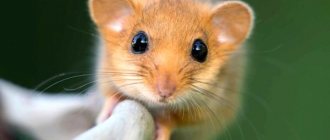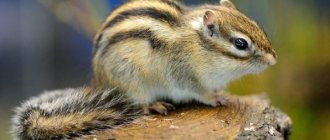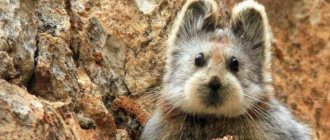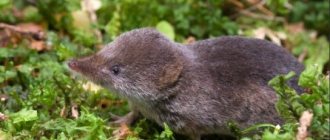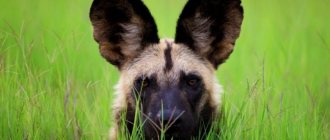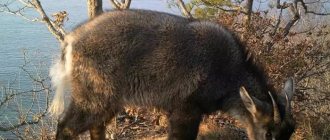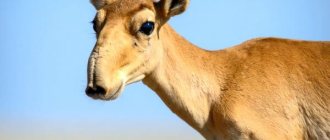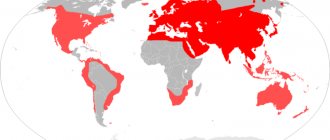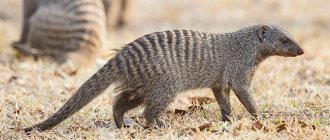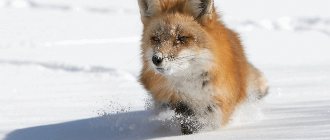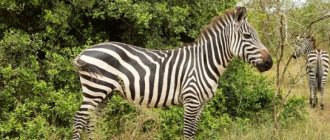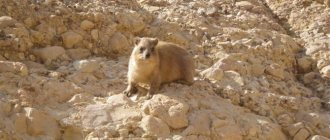Sonya Polchok is a rodent that closely resembles a squirrel. It lives in many Russian regions. This is a herbivore that lives in trees and feeds on nuts, fruits, and grains.
Dormice are suitable for keeping at home and are sold in pet stores. The animal got its name because it sleeps during daylight hours and leads an active lifestyle at night.
Origin of the species
Dormouse is a rodent that belongs to the dormouse family. Outwardly, it vaguely resembles a mouse in fur color and habits. There are 28 species of dormouse in the world, but only a few of them live in Russia.
The first representatives of the dormouse family appeared in the historical period of the Middle Eocene. These animals first appeared in Asia. The following representatives of the family are common on the territory of the Russian Federation:
- Polchki;
- Nut dormice;
- Garden dormice;
- Forest dormouse.
The first of the above species is listed in the Red Book of Russia.
Description of Sonya Polchka
The largest representative of dormouse in size is significantly larger than its closest relative, the hazel dormouse. The rodent has a funny appearance, but in captivity such an animal does not become completely tame and, if handled carelessly or incorrectly, may very well bite its owner.
Appearance, dimensions
The average body length of an adult varies between 13-18 cm, with a weight of 150-180 grams. In appearance, the shelf resembles a gray miniature squirrel, without the presence of tassels on its round-shaped ears. The palms and feet are bare, fairly wide, with tenacious, mobile fingers. The 1st and 5th toes are particularly mobile on the foot; they can be retracted quite easily perpendicularly in relation to the other toes. The hands are turned outward at an angle of about 30°. Thanks to this feature, the shelves can move even along rather thin branches.
The nimble animal quickly climbs tree trunks up and down and can jump over branches at a distance of up to ten meters. The dormouse's tail is fluffy, grayish-whitish in color, with an average length of 11 to 15 cm. The dormouse's fur is not too high, but quite lush, consisting mainly of downy hair. The regiment's coloring is almost completely monochromatic. The color is dominated by only two colors: grayish-brown and smoky gray on the back, as well as white or yellowish in the belly area. There may be dark thin rings around the eyes, which are sometimes almost invisible.
An interesting fact is that adult dormouse have rather long whiskers, which are in constant motion, but the left and right tuft of whiskers are able to move completely independently of each other.
Lifestyle, behavior
Dormouses are very attached to mixed and deciduous forests, where they have a varied food supply. The animals prefer to inhabit the densest forest zones, which are distinguished by a noticeable number of berry fields and wild fruit trees. Dormouses often settle in orchards and vineyards or in close proximity to them. In the mountains, the mammal is able to rise to the borders of broad-leaved forests, up to approximately two thousand meters above sea level.
The dormouse feels great in a mature forest with a predominance of beech, oak, hornbeam and linden, with a rich undergrowth based on fruit bushes in the form of hawthorn, dogwood and hazel, as well as honeysuckle. In the northeastern part of the Russian range, the dormouse lives in oak-linden forests with maple, elm, aspen, hazel, and raspberries and blackberries in the lower tier. In the coastal rocky zone, the rodent lives mainly in rocky crevices.
Until the end of spring or until June, the dormouse remains in hibernation, and such animals awaken later than other members of the family. For example, in the Caucasus, chickweeds leave their shelters en masse around the end of June, when mulberry and cherry plum fruits ripen. Adult males leave special scent marks on tree branches, the smell of which even humans can smell. During hibernation, as a rule, approximately two-thirds of the young of the year die, because they did not have time to accumulate a sufficient amount of fat reserves or chose the wrong place for wintering.
During hibernation, the animals' metabolism slows down to 2%, body temperature drops to 3°C, heart contractions become minimal, and slow breathing can sometimes stop for a while.
How long do regiments live?
Dormouses do not live too long in natural conditions, usually no more than four years. In captivity, the average life expectancy of such mammals increases slightly.
Sexual dimorphism
Signs of sexual dimorphism are not expressed in either size or fur color in the dormouse. Adult female and male rodent mammals look exactly the same.
Return to content
Lifestyle
- Representatives of the family got their name due to the fact that they sleep for the main part of their existence. They are active exclusively at night, creating a lot of noise. Dormice sleep in the winter, from October to April. They create burrows underground and climb into them. It turns out that these individuals spend more than ½ of their lives sleeping.
- The interesting thing is that during hibernation the animal can easily be picked up. The rodent will not wake up. Individuals like low temperatures. When cold weather sets in, they can sleep for 3 or more days without waking up.
- It was already mentioned earlier that wakefulness occurs at night. These animals come out of their houses and begin to search for food. They crawl and jump on branches and bushes, leaning on strong paws. They skillfully jump from one place to another, without weighing down the branches at all.
- Sleepyheads mean peace-loving creatures, distinguished by their gullibility. They can easily be trained and quickly get used to people, which is why they are kept in an apartment or private house along with hamsters. These animals are considered extremely popular in the UK. They get along well with children. However, what frightens people is that the rodent is nocturnal; not everyone will like rustling noises during sleep.
- Now let's look at life expectancy. These individuals live no more than three years. They, of course, can live up to 7 years, but this is only if they maintain the house. Usually the cause of sudden death is ecology or a sudden change in climate. A lot of rodents freeze out in winter.
Range, habitats
Polchok is widespread in the mountain and lowland forests of Europe, the Caucasus and Transcaucasia, and is found from the northern part of Spain and France to Turkey, the Volga region and the northern part of Iran. The species was introduced into Great Britain (Chiltern Hills). The dormouse is found on the island territories of the Mediterranean Sea, including Sardinia, Corsica, Sicily, Crete and Corfu, as well as Turkmenistan near Ashgabat.
On the territory of the Russian Federation, the dormouse is found very unevenly. The habitat of this mammal is represented by several isolated areas of different sizes, often located at a considerable distance from each other. Dormouse can be found in the Kursk region and in the Volga river basin, including the Volga-Kama region, Nizhny Novgorod region, Tatarstan, Chuvashia and Bashkiria, Samara region.
In the north of our country, the distribution of the rodent is limited to the Oka River. In the steppe southern regions of the European part, the dormouse is absent. The most common and numerous such animal is in Transcaucasia and the Caucasian Isthmus. Factors limiting the total number of individuals include the small number of mammals in the northern limits of the range, as well as the insufficient number of optimal habitats.
Experts have recommended, as measures to preserve representatives of the species in nature, a special study of the current distribution areas and the total number of the species, as well as the identification and subsequent protection of the habitat.
Return to content
Keeping regiments in captivity
These animals are not often kept at home, since they spend more than six months in hibernation. They are active at night, and their kidneys do not like attention paid to them. In captivity they are not tamed and can even bite.
Caring for them is similar to squirrels. They are fed the same food, with the exception of cones. The dormouse eats about 40 grams of juicy mass per day. When kept in a warm room, the pods do not hibernate.
In some European languages, the dormouse is called "edible dormouse."
Disruption of their natural biorhythm affects the ability to reproduce, therefore, in order to achieve offspring from a shelf, it is necessary to provide him with peace for the winter and keep him indoors at a temperature of no more than plus 5 degrees.
There are 3 types of dormouse common in our country: forest, garden and hazel. All these species are smaller in size than half-shelves. Dormouse can be bought at a pet store or caught in a birdhouse at the end of winter. At this time, their sleep is more sound, and they do not react to the appearance of a person. The little ones wake up only in a warm room. When the animal wakes up, it should be fed with milk, vegetables and fruits. Over time, they will get used to different foods.
If you find an error, please select a piece of text and press Ctrl+Enter.
Dormouse diet
According to the typical feeding habits, dormouse are vegetarians, so the basis of their food is represented by vegetative parts of all kinds of vegetation, fruits and seeds. At the same time, animals prefer seeds, not pulp, in berries and fruits. The main diet of a dormouse includes:
- acorns;
- hazel;
- walnuts;
- chestnuts;
- beech nuts;
- pears;
- grape;
- apples;
- cherries;
- plum;
- mulberry;
- cherry plum;
- mulberries.
There is no consensus regarding the consumption of animal food by dormouse. Some researchers fully accept the rare predation of dormouse. Sometimes rodents eat small chicks and insects along with plant food. Forest mammals prefer ripe fruits and berries, so when feeding, the animal first tastes the fruits, and insufficiently ripe food is thrown onto the ground.
As practice shows, unripe fruits scattered by dormice often attract wild boars and bears, and are also actively used as food by various terrestrial mouse-like rodents.
Return to content
Reproduction and offspring
Dormouses make nests in tree hollows or rocky voids, as well as under fallen tree trunks. The inside of the nest is made by the animal from plant fibers, fluff and moss. Often the nest is built in bird shelters or on top of them, which causes the death of eggs and chicks. About ten days after awakening, the males begin the rutting period. At this time, adult females are already entering estrus.
The rutting period is noisy and is accompanied by increased activity in males and fairly frequent fights between adults. In addition to very odorous marks, another sign of the rut is the rather loud sounds the animals make at night, represented by sharp cries, grumbling, whistling and grunting. Of particular interest is the so-called singing of the regiment, which resembles the sounds of “ttsi-ttsi-ttsi” made over several minutes. Immediately after mating, the created pairs of forest mammals break up.
The female's pregnancy lasts four weeks or a little more. The number of cubs in a litter can vary from one to ten. Most often, five babies are born, each weighing 1-2 g. The development process of newborns is quite slow. After about the twelfth day, the cubs' ear canals open, and at the age of two weeks the very first incisors erupt. The eyes of baby dormouse open at about three weeks of age.
Even before the cubs mature, females begin to feed their offspring from the mouth with well-softened and crushed food in the form of leaves, berries and fruits. From day 25, babies are already trying to feed themselves. At five weeks of age, the dormouse's offspring leave their usual parental nest and settle down. The chicks reach sexual maturity in the next year, but they begin the reproduction process only in the second or third year of life. There are two breeding peaks throughout the year, which occur at the end of June and beginning of August.
Return to content
Chuvash Republic
Status: IV category. Species with uncertain status.
Spreading
In Chuvashia it is found in the Sur region, the Volga region, the Center, and the Yadrinsky Zasur region.
Number
Few in number. After the frosts of 1978/1979. and the death of a significant number of oaks and hazel, the number fell sharply, but subsequently partially recovered. Current population trends are unknown. The livestock is positively affected by the harvest of fruit and berry plants, acorns and nuts.
Source: Red Book of the Chuvash Republic. Volume 1. Part 2. Rare and endangered species of animals. Ed. Isaev I.V., Dmitriev A.V. (2010) Cheboksary: State Unitary Enterprise IPK Chuvashia
Natural enemies
The dormouse does not have too many enemies, but even in ancient Rome, the meat of such small mammals was considered a delicacy. The animals were specially bred in special fenced gardens or gliaria. The resulting rodent carcasses were baked with poppy seeds and honey. In the Balkans in the seventeenth century, dormouse meat was marinated in a spicy sauce.
In addition to people, the forest polecat was a danger to the small rodent mammal. This animal from the mustelid family, a close relative of the ermine and weasel, is distinguished by an elongated long body and short legs. Forest ferrets prefer to settle in small river floodplains and forest edges. The dexterous and incredibly nimble polecat is able to quite easily penetrate the hollows of dormice.
Adult dormouse is also hunted by owls, who choose open, damp spaces with small bushes to catch prey. At the same time, owls can hunt not only at night, but also during daylight hours. The feathered predator does not like to guard rodents, but prefers to circle over the clearings. Seeing its prey, the owl suddenly falls down and very deftly grabs the rodent. Of all the owls that live in Russia, the short-eared owl is the only species that is capable of building its own nests.
The dormouse's tail often saves its owner's life: the animal's skin has thin areas that easily tear under any tension, and the skin peeling off like a stocking gives the rodent the opportunity to escape.
Return to content
Tail or life?
An incredible and surprising property of the tail of all dormouse is autotomy.
If you grab a fleeing dormouse by the tail, the skin will tear and peel off the shaft, like a glove from a hand. The remaining bare twig will dry out and fall off, or over time the dormouse will gnaw it off itself.
Without a tail, it is not so easy to jump and maintain balance, but it is still better than losing your life. Remember this when trying to catch a fleeing animal, and under no circumstances catch it by the tail!
Life expectancy is up to 3 years, with an exception of 4 years.
Population and species status
The dormouse is a very rare mammal in the Baltic countries, but is considered quite common in Western and Southern Europe. In the northeastern and northern parts of the range, the bats live in a mosaic pattern. In the Carpathians, the Caucasus and Transcaucasia, dormouse are considered very numerous. Here, small rodents get along quite well even next to people, so they often cause noticeable damage to vineyards, berry fields and orchards.
Dormouse fur is quite beautiful, but is currently harvested only in small quantities. The species was listed in the Red Books of the Tula and Ryazan regions. In the first edition of the Red Book of the Moscow Region (1998), representatives of the species were included in the list of Appendix No. 1. Despite the limited distribution in some territories, according to experts, today there is absolutely no need for artificial breeding of the dormouse.
Return to content
Republic of Tatarstan
Status: I category. A rare species, on the eastern border of its range.
Spreading
In Tatarstan, the main occurrences of the species occur on the right bank of the Volga. Recorded in Verkhneuslonsky, Kamsko-Ustinsky (villages of Antonovka and Syukeevsky Vzvoz) and Tetyushsky districts. The location of the find in the Zelenodolsk region does not correspond to reality. In 2007, it was found in the area of the village of Dolgoy Polyany, Tetyushsky district, and in the vicinity of the village of Tatarskie Shatrashany, Drozhzhanovsky district, on the border with the Ulyanovsk region. Meetings were noted in the area of the KFU zoo station and in the forest near the village of Shelanga, Verkhneuslonsky district, in July 2012 and June 2013, and are observed annually near the village of Studenets. Bone remains were found in the pellets of an eagle owl in a forest in the area of the Verkhnie Tarkhany settlement, Tetyushsky district, in August 2012. Apparently, the species tends to expand its range; data appears on the colonization of the left bank of the river by this species. Volga. Thus, in August 2014, a family was noted: a female with young (an adult female fell into a glue trap, was freed and released) in a garden plot northwest of the village of Usady (fat processing plant) in Laishevsky district.
Number
Small species, no registration data available.
Source: Red Book of the Republic of Tatarstan. Animals, plants, mushrooms. Ed. A.A. Nazirov (2016) Kazan: Idel-Press
